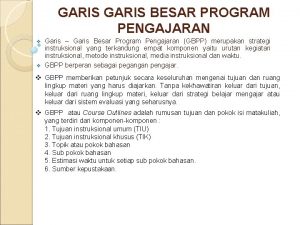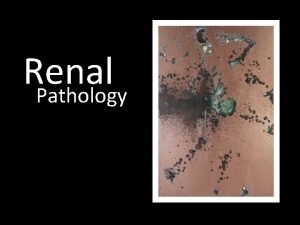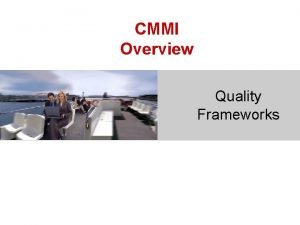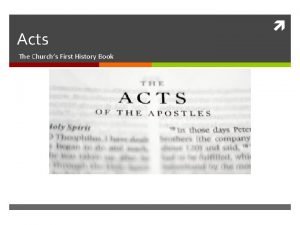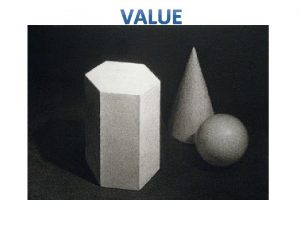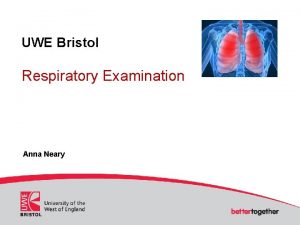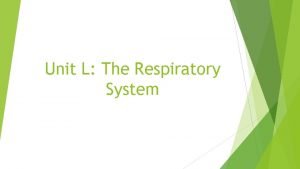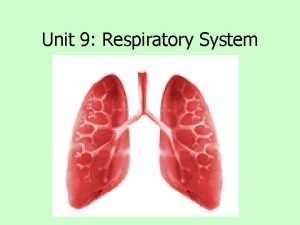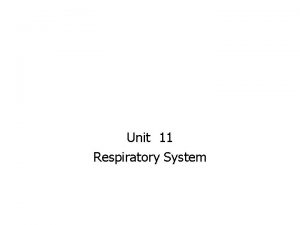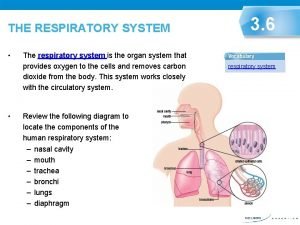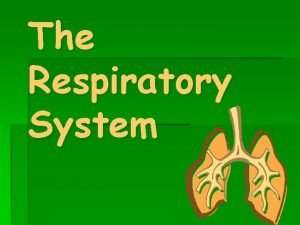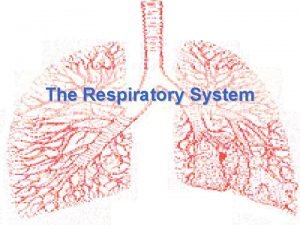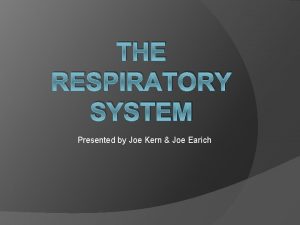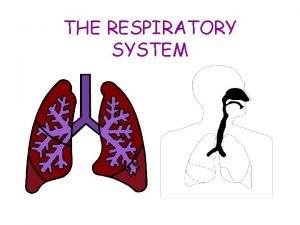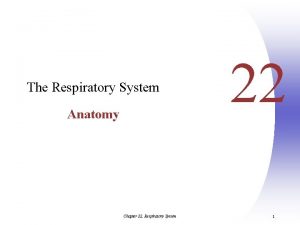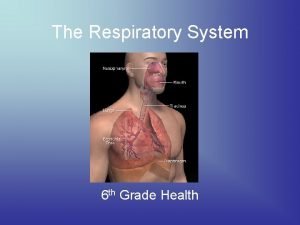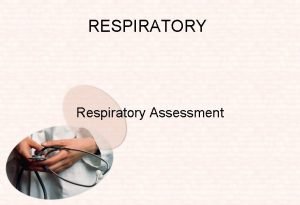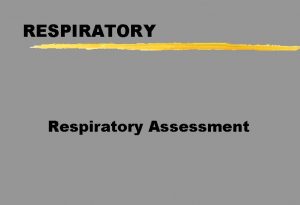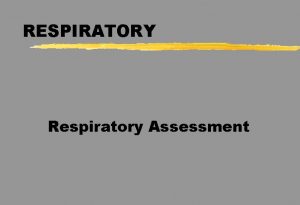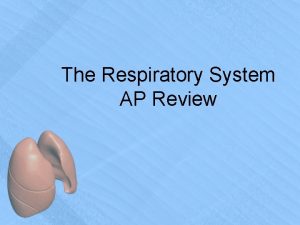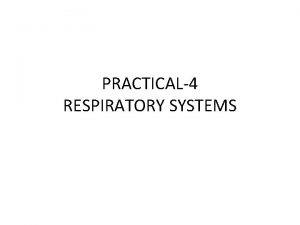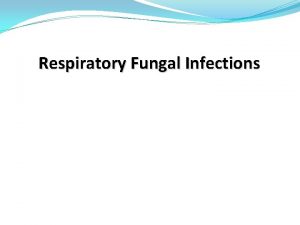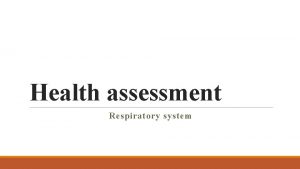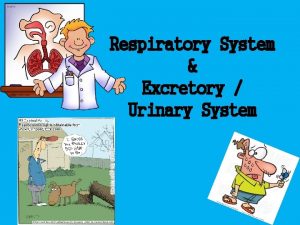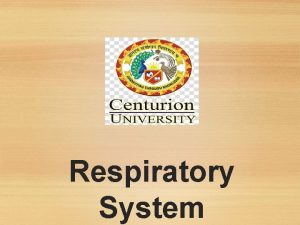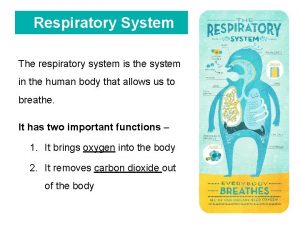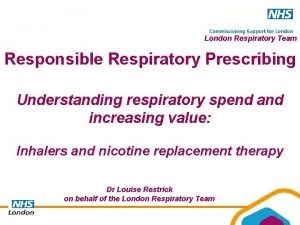Assessment of respiratory system Outlines l l l








































- Slides: 40

Assessment of respiratory system

Outlines l l l l anatomy and physiology of respiratory system Assessment of respiratory system ] 1 Position/Lighting/Draping 2 Inspection • • 2. 1 Chest wall deformities 2. 2 Signs of respiratory distress • 5. 1 Vocal fremitus (not usually done) 3 Palpation 4 Percussion 5 Ausculation l

Anatomy and physiology l l The respiratory tract extends from the nose to the alveoli and includes not only the airconducting passages also but the blood supply The primary purpose of the respiratory system is gas exchange, which involves the transfer of oxygen and carbon dioxide between the atmosphere and the blood. The respiratory system is divided into two parts: the upper respiratory tract and the lower respiratory tract

The upper respiratory tract includes l l The nose pharynx larynx, and trachea.

The lower respiratory tract consists of l l l the bronchi, Bronchioles alveolar ducts and alveoli With the exception of the right and left main-stem bronchi, all lower airway structures are contained within the lungs.

l l The right lung is divided into three lobes (upper, middle, and lower) the left lung into two lobes (upper and lower) The structures of the chest wall (ribs, pleura, muscles of respiration) are also essential



Physiology of Respiration Ventilation involves inspiration (movement of l air into the lungs) and expiration (movement of air out of the l lungs). Air moves in and out of the lungs because intrathoracic l pressure changes in relation to pressure at the airway opening. l Contraction of the diaphragm and intercostal and scalene muscles l increases chest dimensions, thereby decreasing intrathoracic pressure. Gas flows from an area of higher pressure (atmospheric) l to one of lower pressure (intrathoracic) l

Equipment Needed l l A Stethoscope A Peak Flow Meter

Surface markings of the lobes of the lung: (a) anterior, (b) posterior, (c) right lateral and (d) left lateral. (UL, upper lobe; ML, middle lobe; LL, lower lobe). ul Ul ml ll a ul ml ll ll b



Position/Lighting/Draping l l l Position – patient should sit upright on the examination table. The patient's hands should remain at their sides. When the back is examined the patient is usually asked to move their arms forward) hug themself position (so that the scapulae are not in the way of examining the upper lung fields. Lighting - adjusted so that it is ideal. Draping - the chest should be fully exposed. Exposure time should be minimized.

The basic steps of the examination l can be remembered with the mnemonic IPPA: l l Inspection Palpation Percussion Auscultation

Health History l l l l Any risk factors for respiratory disease smoking • • exposure to smoke history of attempts to quit, methods, results • Dust, chemicals, air pollution inactive lifestyle, immobilization age environmental exposure obesity family history

Cough l Type • dry, moist, wet, productive • activities, time of day, weather • l l l Onset Duration Pattern Severity Wheezing Associated symptoms Treatment and effectiveness

sputum l l l amount color presence of blood (hemoptysis) odor consistency pattern of production

Past Health History l l l l l Respiratory infections or diseases (URI) Trauma Surgery Chronic conditions of other systems Family Health History Tuberculosis Emphysema Lung Cancer Allergies Asthma

Inspection l l l Tracheal deviation (can suggest of tension pneumothorax Chest wall deformities ] Kyphosis - curvature of the spine - anterior-posterior Scoliosis - curvature of the spine - lateral Barrel chest - chest wall increased anterior-posterior; normal in children; typical of hyperinflation seen in COPD

Thoracoplasty with secondary changes in the spine. Kyphosis Pectus exacavatum

Signs of respiratory distress l l l Cyanosis - person turns blue Pursed-lip breathing - seen in COPD (used to increase end expiratory pressure ( Accessory muscle use) scalene muscles ( Diaphragmatic paradox - the diaphragm moves opposite of the normal direction on inspiration; suspect flail segment in trauma Intercostal indrawing

‘blue bloater’ showing ascites from marked cor pulmonale. ‘pink puffer’. Note the pursed-lip breathing .


Palpation Tactile fremitus l is vibration felt by palpation. Place your open palms against the upper portion of the anterior chest, making sure that the fingers do not touch the chest. Ask the patient to repeat the phrase “ninety-nine” or another resonant phrase while you systematically move your palms over the chest from the central airways to each lung’s periphery. You should feel vibration of equally intensity on both sides of the chest. Examine the posterior thorax in a similar manner. The fremitus should be felt more strongly in the upper chest with little or no fremitus being felt in the lower chest

Assessing chest expansion in expiration (left) and inspiration (right). Percussion over the anterior chest. Direct percussion of the clavicles for disease in the lung apices


Auscultation l l To assess breath sounds, ask the patient to breathe in and out slowly and deeply through the mouth. Begin at the apex of each lung and zigzag downward between intercostal spaces. Listen with the diaphragm portion of the stethoscope.

l l l Normal breath sounds Note Pitch Intensity Quality Duration


Normal Breath Sounds l l Bronchial : Heard over the trachea and mainstem bronchi (2 nd-4 th intercostal spaces either side of the sternum anteriorly and 3 rd-6 th intercostal spaces along the vertebrae posteriorly). The sounds are described as tubular and harsh. Also known as tracheal breath sounds. Bronchovesicular : Heard over the major bronchi below the clavicles in the upper of the chest anteriorly. Bronchovesicular sounds heard over the peripheral lung denote pathology. The sounds are described as medium-pitched and continuous throughout inspiration and expiration. Vesicular : Heard over the peripheral lung. Described as soft and low- pitched. Best heard on inspiration. Diminished : Heard with shallow breathing; normal in obese patients with excessive adipose tissue and during pregnancy. Can also indicate an obstructed airway, partial or total lung collapse, or chronic lung disease.


Tactile Fremitus

Tactile Fremitus l l Ask the patient to say "ninety-nine" several times in a normal voice. Palpate using the ball of your hand. You should feel the vibrations transmitted through the airways to the lung. Increased tactile fremitus suggests consolidation of the underlying lung tissues





Normal auscultatory sound

Posterior Chest Anterior Chest
 Respiratory zone vs conducting zone
Respiratory zone vs conducting zone Digestive system respiratory system and circulatory system
Digestive system respiratory system and circulatory system How respiratory system work with circulatory system
How respiratory system work with circulatory system Circulatory system and respiratory system work together
Circulatory system and respiratory system work together Parallelism in outlines
Parallelism in outlines Lesson outline for teaching
Lesson outline for teaching Prison ministry training manual download
Prison ministry training manual download Foley v classique coaches
Foley v classique coaches Four main components for effective outlines
Four main components for effective outlines A business plan is a document that outlines
A business plan is a document that outlines Pathology outline
Pathology outline 2 kings 4 8 17
2 kings 4 8 17 Anime character outline
Anime character outline Two types of outlines
Two types of outlines Haunted house outlines
Haunted house outlines Ksf outlines
Ksf outlines Mucoepidermoid carcinoma histology
Mucoepidermoid carcinoma histology Cmmi model outlines
Cmmi model outlines Acts 9 outline
Acts 9 outline Exegetical outline
Exegetical outline Ncic hosts restricted files and non-restricted files
Ncic hosts restricted files and non-restricted files Mun position paper outline
Mun position paper outline Visible outlines
Visible outlines Crohn's disease pathology outlines
Crohn's disease pathology outlines Disaster management in libraries and information centres
Disaster management in libraries and information centres Mid axillary line
Mid axillary line Nottingham city hospital respiratory assessment unit
Nottingham city hospital respiratory assessment unit Bozeman respiratory system
Bozeman respiratory system Unit 9 respiratory system
Unit 9 respiratory system Diagnostic test of respiratory system
Diagnostic test of respiratory system Respiratory system
Respiratory system What are the c shaped rings in trachea
What are the c shaped rings in trachea Respiratory system coloring page
Respiratory system coloring page Respiratory system purpose
Respiratory system purpose Conclusion about respiratory system
Conclusion about respiratory system Respiratory system jobs
Respiratory system jobs Chapter 7:10 respitory system
Chapter 7:10 respitory system Respiratory tree divisions
Respiratory tree divisions Respiratory perfusion
Respiratory perfusion Interesting facts about respiratory system
Interesting facts about respiratory system Upper airway anatomy
Upper airway anatomy





